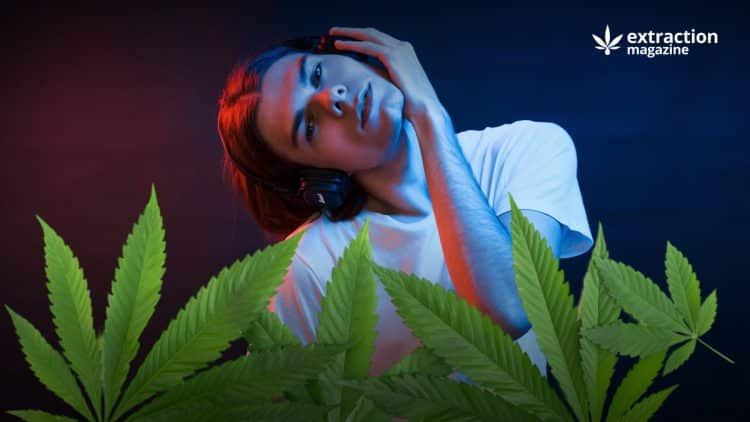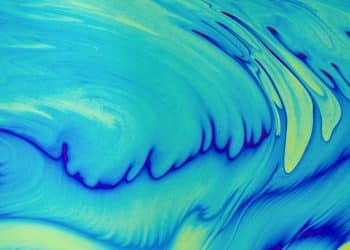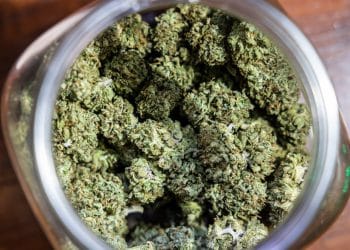The safety of cannabis has been confirmed when comparing it to other psychoactive substances. The risk of exposure to cannabis is approximately 100 times lower than other drugs like alcohol, opiates, cocaine, or amphetamines.[1] Nevertheless, just because cannabis’ dangers are lower does not mean it is entirely free from potential adverse consequences.
Physiological Response of Cannabis Intoxication
The two primary cannabinoids, tetrahydrocannabinol (THC) and cannabidiol (CBD), interact with two distinct cannabinoid receptors within the body, called CB1 and CB2. [2]
THC interacts primarily with CB1 receptors, which tend to be concentrated on nerve cells in the brain and spinal column. This is why the primary intoxication from cannabis tends to be more cerebral, and less physical.
CBD, in contrast, bonds primarily with CB2 receptors, which are found in both the brain and the rest of the body. CBD is not psychoactive, but because of the location of CB2 receptors, it has both neurological and physical side effects. [3][4]
With this in mind, it is still possible to experience a cannabis overdose, but a better word may be overconsumption. This is because imbibing enough cannabis to cause death extremely unlikely, but the way cannabis is ingested does play a role in how it is metabolized. [5]
When inhaled, cannabis is quickly absorbed into the bloodstream, where it can be processed relatively quickly by the liver. Following inhalation, the effects are almost immediate, with a peak lasting for approximately 1-2 hours.
When ingested, cannabis is absorbed through the digestive system and must first go through the liver before entering the bloodstream. Because of this, the onset takes much longer, but it offers a much higher threshold for how many cannabinoids can be absorbed. This is why the risk of discomfort from overconsumption of cannabis is higher when eaten compared to when it is inhaled. [6]
Symptoms of acute cannabis intoxication can include anxiety, panic attacks, unresponsiveness, increased heart rates, and spikes in blood pressure. [7] While these symptoms may appear relatively mild in comparison to other overdoses, hospitalizations are possible following overconsumption of cannabis.
Psychological Disorders and Cannabis
More concerning than the short term risks associated with cannabis use are the statistical possibility of developing long term mental disorders from frequent use.
The most troubling is the risk of developing psychosis, specifically in the form of schizophrenia. [8] The cause of schizophrenia is unknown, so it is impossible to determine the extent that cannabis use may cause the disorder. One study found that cannabis use can increase the risk of developing long term psychosis by as much as 37%, but this number should be taken with caution. [9] The study evaluated candidates who were already predisposed to developing schizophrenia, and not of the population as a whole. In reality, the current opinion is that most cannabis users are not likely to develop this psychological disorder, but it does have the potential of unlocking it in those who may already be at risk due to genetic or other external factors.
When looking at the general population, only 0.47% of users report developing long term cannabis associated psychotic symptoms. [10] So while the risk is generally low, it may be higher for certain individuals. Evidence suggests that the probability increases for cannabis users who started using during adolescence, and the odds are also higher for men than for women. [11][12]
Beyond psychosis, cannabis users also have the potential to develop anxiety and depression. [13][14] While a link does appear to exist, it may be a question of correlation and causation. These conditions only appear to develop with heavy cannabis use, and are rare for those who only consume it occasionally. One theory to account for this is that those who suffer from anxiety or depression may choose cannabis to self-medicate. [15] This may exacerbate the problem though, as THC can magnify these conditions, while CBD may help temper them. [16][17]
Substance Abuse and Long Term Risk
While substance abuse can be classified as a psychological problem, it falls into a slightly different category. As a psychoactive compound, it is possible to become addicted to cannabis, which usually takes the form of psychological addiction. [18]
Physical withdrawal symptoms are also possible, but they do not affect all users equally. [19] The longer the addiction persists, the more likely long term health complications are to develop. With sustained cannabis use, the effects can be similar to tobacco smokers. This can take the form of heart disease, lung damage, and possibly cancer. [20][21][22]
These symptoms are all likely related to inhaling smoke into the lungs, but it is also possible for cannabis to impact the gastrointestinal tract as well.
Long term cannabis use may also lead to the development of cannabinoid hyperemesis syndrome (CHS). [23] The full causes of this syndrome are not fully understood, but it is identified by frequent and intense vomiting.
There are also potential reproductive risks associated with extended cannabis use. For women, it is always a good idea to avoid any psychoactive substances during pregnancy, including cannabis. Evidence has linked cannabis use during pregnancy to lower birth weights and to later cognitive development problems for the child. [24]
For men, long term cannabis use has been shown to lower sperm counts, and may lead to DNA methylation in sperm as well. [25]
Finally, there is conflicting evidence about how much cannabis use may alter the brain. One study found that cannabis use early in life may lead to a 6-8 point drop in IQ. [26] On the other hand, another study conducted on twins where one used cannabis and the other abstained showed no major differences between their brains. [27] One explanation for this seems to point to cannabis affecting both white matter and hippocampal volume, but more evidence is needed to determine both the link to cannabis and the confirmation of cognitive decline. [28]
References:
- Lachenmeier, Dirk W., and Jürgen Rehm. “Comparative risk assessment of alcohol, tobacco, cannabis and other illicit drugs using the margin of exposure approach.” Scientific reports 5.1 (2015): 1-7.
- Mackie, Ken. “Cannabinoid receptors: where they are and what they do.” Journal of neuroendocrinology 20 (2008): 10-14.
- R de Mello Schier, Alexandre, et al. “Antidepressant-like and anxiolytic-like effects of cannabidiol: a chemical compound of Cannabis sativa.” CNS & Neurological Disorders-Drug Targets (Formerly Current Drug Targets-CNS & Neurological Disorders) 13.6 (2014): 953-960.
- Jîtcă, George, et al. “Cannabidiol: Bridge between Antioxidant Effect, Cellular Protection, and Cognitive and Physical Performance.” Antioxidants 12.2 (2023): 485.
- Sharma, Priyamvada, Pratima Murthy, and MM Srinivas Bharath. “Chemistry, metabolism, and toxicology of cannabis: clinical implications.” Iranian journal of psychiatry 7.4 (2012): 149.
- White, Alice E., et al. “Cannabis-infused edible products in colorado: Food safety and public health implications.” American journal of public health 110.6 (2020): 790-795.
- Baraniecki, Robert, et al. “Acute cannabis intoxication in the emergency department: the effect of legalization.” BMC emergency medicine 21.1 (2021): 1-8.
- Semple, David M., Andrew M. McIntosh, and Stephen M. Lawrie. “Cannabis as a risk factor for psychosis: systematic review.” Journal of psychopharmacology 19.2 (2005): 187-194.
- Vaucher, Julien, et al. “Cannabis use and risk of schizophrenia: a Mendelian randomization study.” Molecular psychiatry 23.5 (2018): 1287-1292.
- Schoeler, Tabea, Jason Ferris, and Adam R. Winstock. “Rates and correlates of cannabis-associated psychotic symptoms in over 230,000 people who use cannabis.” Translational psychiatry 12.1 (2022): 369.
- Casadio, Paola, et al. “Cannabis use in young people: the risk for schizophrenia.” Neuroscience & Biobehavioral Reviews 35.8 (2011): 1779-1787.
- Hamilton, Ian, Paul Galdas, and Holly Essex. “Cannabis psychosis, gender matters.” Advances in Dual Diagnosis (2015).
- Crippa, José Alexandre, et al. “Cannabis and anxiety: a critical review of the evidence.” Human Psychopharmacology: Clinical and Experimental 24.7 (2009): 515-523.
- Degenhardt, Louisa, Wayne Hall, and Michael Lynskey. “Exploring the association between cannabis use and depression.” Addiction 98.11 (2003): 1493-1504.
- Grant, Bridget F., and Roger Pickering. “The relationship between cannabis use and DSM-IV cannabis abuse and dependence: results from the National Longitudinal Alcohol Epidemiologic Survey.” Journal of substance abuse 10.3 (1998): 255-264.
- Panlilio, Leigh V., et al. “Previous exposure to THC alters the reinforcing efficacy and anxiety-related effects of cocaine in rats.” Neuropsychopharmacology 32.3 (2007): 646-657.
- Blessing, Esther M., et al. “Cannabidiol as a potential treatment for anxiety disorders.” Neurotherapeutics 12.4 (2015): 825-836.
- Zehra, Amna, et al. “Cannabis addiction and the brain: a review.” Journal of Neuroimmune Pharmacology 13 (2018): 438-452.
- Smith, Neil T. “A review of the published literature into cannabis withdrawal symptoms in human users.” Addiction 97.6 (2002): 621-632.
- Page, Robert L., et al. “Medical marijuana, recreational cannabis, and cardiovascular health: a scientific statement from the American Heart Association.” Circulation 142.10 (2020): e131-e152.
- Kaplan, Alan G. “Cannabis and Lung Health: Does the Bad Outweigh the Good?.” Pulmonary therapy 7.2 (2021): 395-408.
- Hall, Wayne, and Donald MacPhee. “Cannabis use and cancer.” Addiction 97.3 (2002): 243-247.
- A Galli, Jonathan, Ronald Andari Sawaya, and Frank K Friedenberg. “Cannabinoid hyperemesis syndrome.” Current drug abuse reviews 4.4 (2011): 241-249.
- Dong, Catherine, et al. “Cannabinoid exposure during pregnancy and its impact on immune function.” Cellular and Molecular Life Sciences 76 (2019): 729-743.
- Payne, Kelly S., et al. “Cannabis and male fertility: a systematic review.” The Journal of urology 202.4 (2019): 674-681.
- Meier, Madeline H., et al. “Persistent cannabis users show neuropsychological decline from childhood to midlife.” Proceedings of the National Academy of Sciences 109.40 (2012): E2657-E2664.
- Agrawal, Arpana, et al. “A twin study of early cannabis use and subsequent use and abuse/dependence of other illicit drugs.” Psychological medicine 34.7 (2004): 1227-1237.
Mandelbaum, David E., and Suzanne M. de la Monte. “Adverse structural and functional effects of marijuana on the brain: evidence reviewed.” Pediatric neurology 66 (2017): 12-20.












